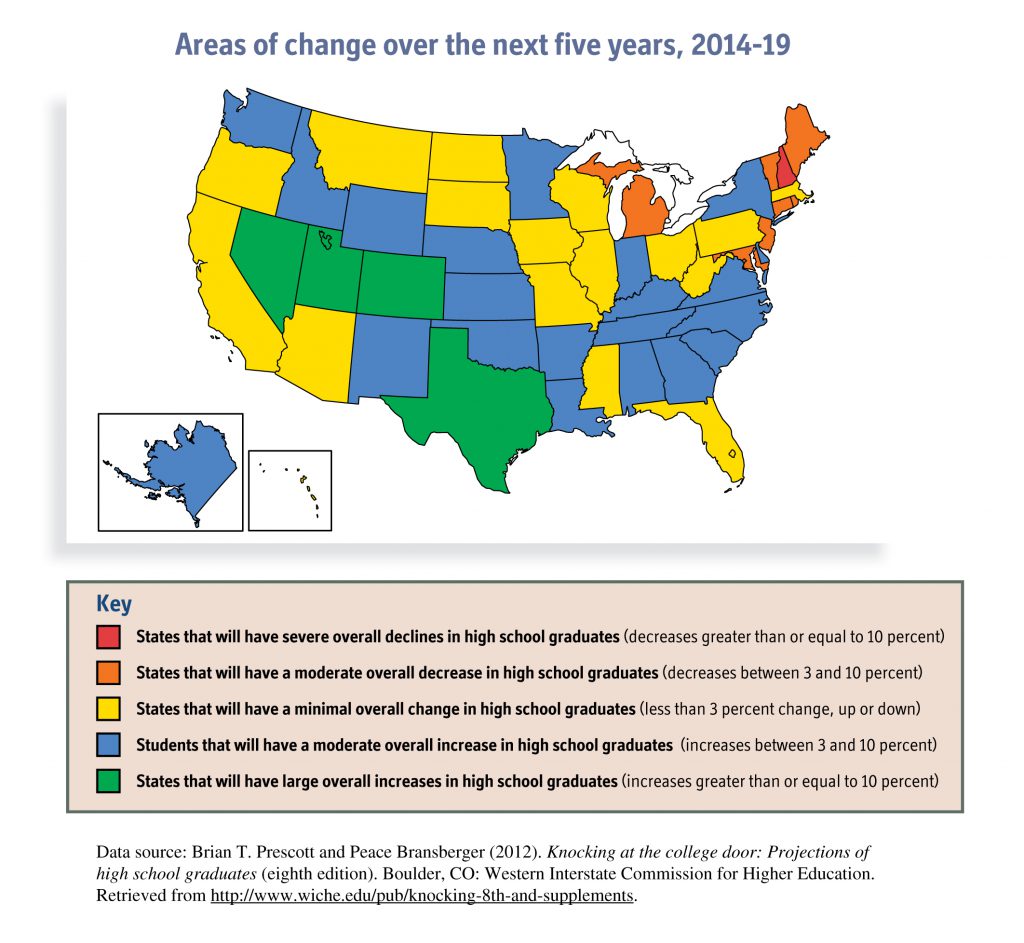enrollment
Projections of high school graduates by state and race/ethnicity for strategic enrollment planning

A special new report from Noel-Levitz compiles pertinent projections over the next five and ten years that may influence enrollments for colleges and universities that primarily serve traditional-age undergraduates.
As shown above in blue and green, 25 states across the U.S. are expected to see increases in their high school graduates of more than 3 percent between 2014 and 2019, according to the latest available data from WICHE, the Western Interstate Commission on Higher Education.
Of these 23 states, seven states will see either an increase of more than 10 percent or grow by more than 5,000 graduating seniors.
Meanwhile, as shown above in red and orange, only eight states and the District of Columbia will experience declines in graduating high school seniors of more than 3 percent between 2014 and 2019.
The report also includes projections over the next 10 years, through 2024, showing 27 states will see increases in graduating seniors of more than 10 percent over the next decade. In addition, California and New York will have 10,000 additional high school seniors even though their growth will be less than 10 percent.
Substantial shifts in high school demographics
When broken down by racial/ethnic groups and by state, these same data for high school graduates show substantial shifts on the horizon:
- Caucasian high school seniors, who account for the majority of the seniors and tend to have high college-going rates, are expected to decline by 1.0 percent at public high schools in five years and by 4.2 percent in 10 years.
- African-American high school seniors, who now have high college-going rates approaching those of Caucasian seniors (see data from the federal government), are expected to increase by 3.4 percent at public high schools in five years and by 7.6 percent in 10 years.
- Asian high school seniors, who have the highest college-going rates, are expected to increase by 16.6 percent at public high schools in five years and by 38.5 percent in 10 years. By volume, nine states will experience an increase of 1,000 or more of these seniors over the next five years, and in the next 10 years, 19 states will experience an increase of 1,000 or more.
- Hispanic high school seniors, who also now have high college-going rates approaching those of Caucasian seniors (again, see federal government data), are expected to increase by 21.8 percent at public high schools in five years and by 44.6 percent in 10 years. By volume, 28 states will experience an increase of 1,000 or more of these seniors over the next five years, and, in the next 10 years, 37 states will experience an increase of 1,000 or more.
Additional factors that could influence college enrollments
In addition to state-by-state breakdowns for each of the above trends, the special report from Noel-Levitz identifies additional factors that will influence enrollments, including a 10-year forecast for online learners from Pew, projections by student age ranges through 2021 from the National Center for Education Statistics, and recent research on college-going rates and student mobility. Don’t miss the report’s section, “Crafting a strategic response,” for a summary of possible strategic responses to the changes.
Want to discuss how these demographics may affect your longer-term strategies for enrollment management?
I hope you have found this post helpful. If Noel-Levitz can be of assistance in helping you plan longer-term, please feel free to email us. Noel-Levitz will also be offering a Strategic Enrollment Planning Executive Forum in April, which will explore key issues and emerging trends, including the expected changes in demographics.
